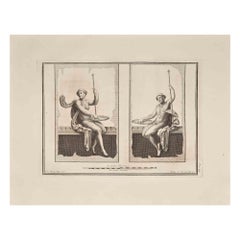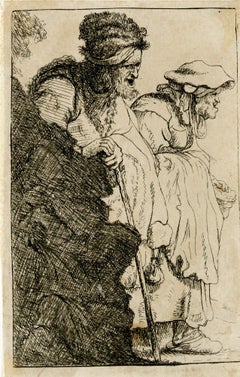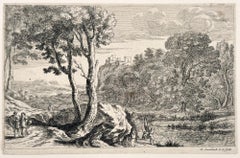Guglielmo Morghen Prints and Multiples
to
2
2
Overall Width
to
Overall Height
to
2
2
1,208
963
915
832
2
2
1
1
2
1
1
1
1
2
Artist: Guglielmo Morghen
Ancient Roman Fresco Herculaneum - Original Etching G. Morghen - 18th Century
By Guglielmo Morghen
Located in Roma, IT
Ancient Roman Scene from the series "Antiquities of Herculaneum", is an original etching on paper realized by Giovanni Morghen in the 18th Century.
Signed on the plate.
Good condit...
Category
Late 18th Century Old Masters Guglielmo Morghen Prints and Multiples
Materials
Etching
Ancient Roman Fresco Herculaneum - Original Etching G. Morghen - 18th Century
By Guglielmo Morghen
Located in Roma, IT
Ancient Roman Scene from the series "Antiquities of Herculaneum", is an original etching on paper realized by Guglielmo Morghen in the 18th Century.
Signed on the plate.
Good condi...
Category
Late 18th Century Old Masters Guglielmo Morghen Prints and Multiples
Materials
Etching
Related Items
Beggar man and woman coming from behind a bank – after Rembrandt van Rijn
By Charles Amand Durand
Located in Middletown, NY
Etching on cream laid paper laid down to a wove paper support, 4 x 2 5/8 inches (101 x 67 mm) (sheet). In good condition with scattered light areas of discoloration. Printed early 19...
Category
17th Century Old Masters Guglielmo Morghen Prints and Multiples
Materials
Laid Paper, Etching
The Anglers
By Herman van Swanevelt
Located in Middletown, NY
Etching with engraving on cream laid paper with a large unidentified alphabetic watermark, 6 1/2 x 9 7/8 inches (165 x 251 mm), the full sheet. In good condition with handling wear a...
Category
Early 17th Century Old Masters Guglielmo Morghen Prints and Multiples
Materials
Laid Paper, Engraving, Etching
Ordinis Benedictini monialis; Saint Thecla of Kitzengen
Located in Middletown, NY
King, Daniel (with Wenceslaus Hollar)
Ordinis Benedictini monialis; Saint Thecla of Kitzengen
c 1650.
Etching with engraving on cream laid paper with an indiscernible watermark wit...
Category
Mid-19th Century Old Masters Guglielmo Morghen Prints and Multiples
Materials
Etching, Laid Paper, Engraving
The Smoker and the Drinker
By Adriaen van Ostade
Located in San Francisco, CA
Artist: Adriaen Van Ostade (Dutch, 1610-1685)
Title: The Smoker and the Drinker
Year: 1650
Medium: Etching
Paper: Laid paper
Image (plate mark) size...
Category
Late 17th Century Old Masters Guglielmo Morghen Prints and Multiples
Materials
Etching
Four original etchings of women from 'Aula Veneris' series by Wenceslaus Hollar
By Wenceslaus Hollar
Located in Milwaukee, WI
Presented here as a group are four original etchings of women in European national dress from the master printmaker Wenceslaus Hollar's series "Aula V...
Category
17th Century Old Masters Guglielmo Morghen Prints and Multiples
Materials
Etching, Paper
The Birth of Adonis; Plate 1 from The Story of Adonis
By Herman van Swanevelt
Located in Middletown, NY
Etching with engraving on thin laid paper with an early and large unidentified heraldic watermark with a windmill, and the collector's stamp of Count F. J. von Enzenberg (1802-1879),...
Category
Early 17th Century Old Masters Guglielmo Morghen Prints and Multiples
Materials
Laid Paper, Engraving, Etching
$500
H 9.73 in W 12.84 in
Beggar Seated on a Bank by Rembrandt Van Rijn
By Rembrandt van Rijn
Located in New Orleans, LA
Rembrandt van Rijn
1606-1669 Dutch
Beggar Seated on a Bank
Etching on paper
New Hollstein's first state of two
Signed and dated in plate "RHL 1630" (lower center)
This remarkable...
Category
17th Century Old Masters Guglielmo Morghen Prints and Multiples
Materials
Paper, Etching
$64,500
H 20.25 in W 16.25 in D 1.25 in
17th century etching black and white figures scene
By Cornelis Bega
Located in Milwaukee, WI
"The Singer" is an original etching by Cornelis-Pietersz Bega. It depicts a performer and onlookers. Publisher: Pearce #50.
4" x 3" art
16 1/2" x 13 1/2" frame
Cornelis Pietersz Be...
Category
Mid-17th Century Old Masters Guglielmo Morghen Prints and Multiples
Materials
Etching
The Bohemians
By Jacques Callot
Located in New York, NY
Jacques Callot (1592-1635), The Bohemians, the set of four etchings touched with burin, 1621. Reference: Lieure 374 (second state of four); Lieure 375-77 (second state of two). In ve...
Category
1620s Old Masters Guglielmo Morghen Prints and Multiples
Materials
Etching
Peasant Family on the Tramp – after Rembrandt van Rijn
By Charles Amand Durand
Located in Middletown, NY
Etching on cream laid paper, 4 5/8 x 3 1/2 inches (118 x 89 mm), thread margins. Laid down to a medium weight laid support, scattered nicks and corner wear. The top and bottom corner...
Category
17th Century Old Masters Guglielmo Morghen Prints and Multiples
Materials
Laid Paper, Etching
$400
H 4.65 in W 3.51 in
"Perseus and Andromeda" figurative black and white mythology scene figurative
By Alexander Runciman
Located in Milwaukee, WI
"Perseus and Andromeda" is an etching by Scottish artist Alexander Runciman, signed in plate to the lower left. It depicts Perseus on the left sw...
Category
1770s Old Masters Guglielmo Morghen Prints and Multiples
Materials
Etching
"Four Women in National Costumes, " Etchings by Wenceslaus Hollar
By Wenceslaus Hollar
Located in Milwaukee, WI
"Four Women in National Costumes" is a set of four original etchings by Wenceslaus Von Prachna Hollar.
3 5/8" x 2 3/8" each print
19 1/8" x 18 1/2" frame
Wenceslaus Von Prachna Ho...
Category
17th Century Old Masters Guglielmo Morghen Prints and Multiples
Materials
Etching
$3,200
H 19.125 in W 18.5 in
Guglielmo Morghen prints and multiples for sale on 1stDibs.
Find a wide variety of authentic Guglielmo Morghen prints and multiples available for sale on 1stDibs. You can also browse by medium to find art by Guglielmo Morghen in etching and more. Much of the original work by this artist or collective was created during the 18th century and is mostly associated with the Old Masters style. Not every interior allows for large Guglielmo Morghen prints and multiples, so small editions measuring 15 inches across are available. Customers who are interested in this artist might also find the work of Giovanni Elia Morghen, Giuseppe Vasi, and Giovanni Battista Tiepolo. Guglielmo Morghen prints and multiples prices can differ depending upon medium, time period and other attributes. On 1stDibs, the price for these items starts at $428 and tops out at $428, while the average work can sell for $428.
Artists Similar to Guglielmo Morghen
Georges-Louis Leclerc, Comte de Buffon



